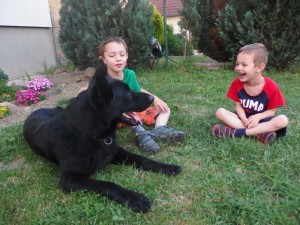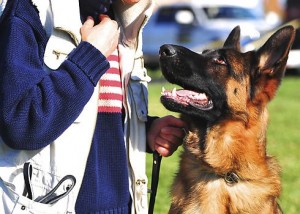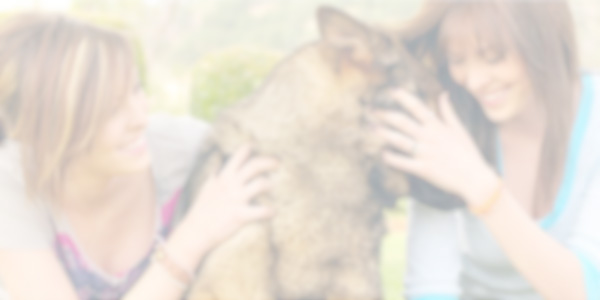The Art of Listening
 Imagine this scenario: a dog is being pet by neighborhood children. He suddenly walks away, and climbs onto the front porch into his bed. The children want to follow the dog onto the porch to keep petting him; this means they would get into his space, be on his property, and also prevent him from escaping a situation he finds uncomfortable. The handler is left with two choices: to either listen to the clear communication that the dog has offered, and thus take action to keep the dog (and children) safe, or to ignore it and assume “oh, he’ll be fine.”
Imagine this scenario: a dog is being pet by neighborhood children. He suddenly walks away, and climbs onto the front porch into his bed. The children want to follow the dog onto the porch to keep petting him; this means they would get into his space, be on his property, and also prevent him from escaping a situation he finds uncomfortable. The handler is left with two choices: to either listen to the clear communication that the dog has offered, and thus take action to keep the dog (and children) safe, or to ignore it and assume “oh, he’ll be fine.”
The foolish handler practices the latter, placing both the dog and children at risk should the dog decide to act out after being followed and cornered. The wise handler, on the other hand, observes their dog moving away from the children the first time, and either prevents the children from following the dog, or puts the dog away in the house where he is safe and unbothered. The wise handler OBSERVES and LISTENS to what the dog was saying, and then TAKES ACTION to protect his dog.
The Power of Listening
Last blog we discussed the art of observing our dogs and their non-verbal communications. But the astute handler or owner moves one step further; they not only observe the situation and the emotions it creates in the dog, but listen to what the dog is “saying” and then take action based on what they see. But what do we mean by ‘listening to the dog?’
Dogs do not lie with their body language; they clearly communicate what they are feeling through their eyes, ears, tail, lips, and overall body. It is one thing to observe the different signals the dog is sending, but a good handler can correctly interpret these signals and respond appropriately to the dog. This is what is described as “listening”. The wise handler does not “brush off” the dog’s discomfort or pretend that the dog is acting differently than it feels (such as insisting that “Fifi” from last blog is just “really shy but likes other dogs”, when in reality she is feeling exceptionally stressed and overwhelmed by meeting a larger, pushier dog.). If a dog is communicating that they are stressed or uncomfortable, then the handler listens to the dog by providing a way out or a means of coping better with the stress at hand. They also may help the dog realize that it is appropriate to ‘take’ the way out when it is offered. This could be as simple as calling the dog over away from a child who is causing the dog stress, or asking for the dog to sit in front and focus on you while at the vet’s office. Not listening to the dog means observing the behavior and then doing nothing about it, relying instead on the dog to ‘handle it’ on his own.
Listening to the dog allows the owner to relieve the stress of the situation, whether it involves removing, protecting, or redirecting the dog. The proactive handler then works on training their dog to better handler or cope with the situation; however, they also work to prevent their dog from getting into situations that would provoke discomfort or anxiety to such a level that the dog resort to violence to make himself heard. Through the art of observation, they are aware of who their dog is, and by listening, they are aware of what their dog needs to handle these situations.
 Listening to the dog also builds trust and respect in the dog-human relationship. In the training relationship and in the personal relationship, trust is developed when the dog realizes he has been heard in his communications. When the handler takes action on the dog’s behalf, the dog understands that he has been ‘heard’. As the relationship between them grows, the dog is able to rely on less dramatic non-verbal communication, as the owner grows more perceptive and more capable of reading their dog. Additionally, should the dog find himself in a stressful situation, he is now more likely to rely on the leadership of his handler and trust that his owner will help protect him and bring him through this situation safely. A dog that is listened to consistently may be less likely to take matters into their own paws, and more likely to respond in a safe and appropriate manner.
Listening to the dog also builds trust and respect in the dog-human relationship. In the training relationship and in the personal relationship, trust is developed when the dog realizes he has been heard in his communications. When the handler takes action on the dog’s behalf, the dog understands that he has been ‘heard’. As the relationship between them grows, the dog is able to rely on less dramatic non-verbal communication, as the owner grows more perceptive and more capable of reading their dog. Additionally, should the dog find himself in a stressful situation, he is now more likely to rely on the leadership of his handler and trust that his owner will help protect him and bring him through this situation safely. A dog that is listened to consistently may be less likely to take matters into their own paws, and more likely to respond in a safe and appropriate manner.
When the owner listens to their dogs, the situations describe in our previous blog, The Art of Observation, are handled much differently, in a manner that protects the dogs and the people around them. In the previous blog, we used the fictional examples of Fifi, the small dog whose owner forced her to meet a large German Shepherd named Buddy, who in turn was involved in an unfortunate situation involving a low-level bite that nevertheless ended his time with his family (and possibly his life). Had Fifi’s owner observed and listened to her dog, she would have never insisted that Fifi meet a dog she had no interest in whatsoever. Fifi’s owner would have protected her from the larger dog, simply by walking Fifi away to a distance where she felt more comfortable. She could have even spoken up to the owners of the larger dog, informing them that “my dog is not dog-friendly!” so that they would hopefully take the hint and rein their dog in more. Had the boy been educated on and held to proper behavior around dogs (which includes not getting into a dog’s private space, nor hugging the dog), and had the parents observed the first subtle signs of discomfort in their dog, then this bite scenario would have never happened. Buddy’s family would have noticed all the non-verbal communications he was giving that indicated he wanted to be left alone, and they could have taken steps to stop their young son from invading his space, or to call Buddy over to defuse the situation.
Powerful things happen when we observe and listen to our dogs, and then take action based on what we see. Many unpleasant situations or encounters could be avoided every year–including many dog bites, particularly to children–if owners and handlers practice the arts of observation and listening to their dogs. Observe, listen, take action, and watch your relationship with your dog flourish!

